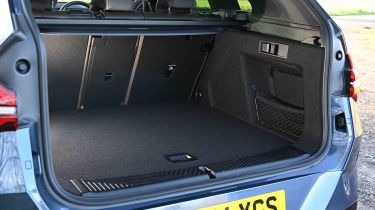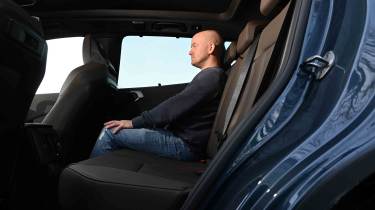BMW X3 - Boot space, comfort & practicality
There’s plenty of room inside the BMW X3, with a good balance between passenger and cargo space

The X3 is a mid-size SUV with five seats and plenty of space in the cabin and boot to accommodate most families. The driving position is a touch on the high side, although this enables a clear view out (helped by A-pillars that aren’t too raked back or thick) and general decent visibility.
Whether you’re trying to carry large passengers, a lot of items or a mixture of both, the X3 offers decent space – if not quite achieving class-leading status in any one area. Tall adults will be able to get comfortable in the X3, whether up front or in the back, although middle-seat occupants might feel cramped after a long trip due to a ridge in the foot space. Despite being a lofty SUV, ease of access to the cabin is good.
Cabin storage is acceptable, with two cupholders in the centre console and a useful storage box under the armrest. You’ll find two bottle holders in the doors for the front occupants, although a two-litre bottle will be a struggle to fit.
| Dimensions | |
| Length | 4,755mm |
| Width | 1,920mm |
| Height | 1,660mm |
| Number of seats | Five |
| Boot space | 570-1,700 litres |
Dimensions and size
The latest X3 is yet another addition to the world of ever-expanding SUVs. It has grown by 34mm in length and is 29mm wider than its predecessor. It is also 25mm lower than before, although in the metal it almost looks like the opposite is true. A mix of an upright nose (fronted by a grille with pinstripes that clash at different angles), a high bonnet and a tiptoe-ish stance means that it doesn’t quite appear as squat and purposeful as the car it replaced. Maybe we’ll have to wait for a full-fat M model for that.
Used - available now
The X3 is also longer, wider and taller than the Mercedes GLC and has a 100mm longer wheelbase. Compared with the outgoing Audi Q5, the BMW is longer and wider, but marginally shorter in height.
How practical is the BMW X3?
Seats & space in the front
Up front, there’s a typically SUV-like raised seating position, and while the screens are big, their widescreen layout means that they don’t encroach into the driver’s view of the road ahead. The thick base of the A-pillar, combined with a chunky door mirror, means that there’s a reasonably large blind spot, which can get in the way a little when approaching a right-angled junction.
Storage points are plentiful and include a large panel for holding smartphones and a roomy centre bin between the front seats. The door bins are spacious, too.
Seats & space in the back
Against the tape measure, the X3 offers almost identical kneeroom to a 3 Series Touring, and slightly less headroom. It’s not cramped by any means, but when compared with its estate-bodied stablemate, it doesn’t really feel like the X3 has capitalised on its extra height, particularly in comparison with some SUV rivals. It is easy to install a child seat, though; tall doors and accessible Isofix points really help here.
Boot space
At 570 litres, the X3 has a huge boot, if not quite the largest in its class. The shape itself is square and the bumper is fairly shallow, so there’s little risk of catching bulky items against it when loading them inside. Fold the rear seats, and the volume grows to 1,700 litres. Helpful features such as a luggage net, movable boot floor and a sliding parcel shelf are fitted as standard in the X3.
Towing
Maximum towing capacity in the X3 with the plug-in hybrid powertrain is 2,000kg. This rises to 2,400kg with the xDrive20 petrol, while the M50 and diesel xDrive20d offer up to 2,500kg. There’s no air suspension to level out once a trailer is fitted, and a tow bar can be added as an extra for just over £1,000.















